指路的英语作文4篇
关于指路的英语 范文
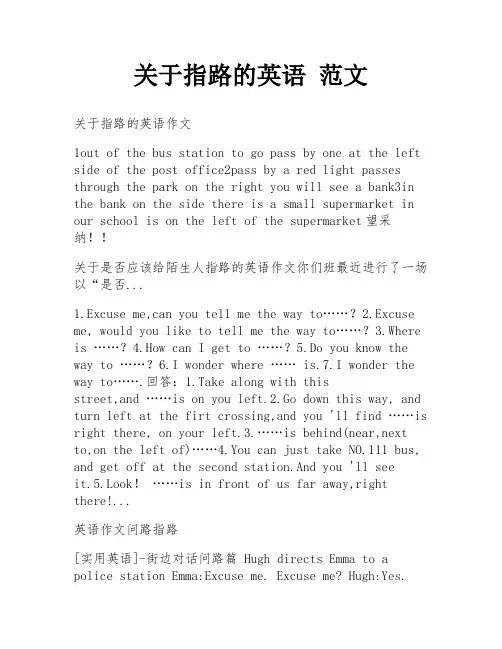
关于指路的英语范文关于指路的英语作文1out of the bus station to go pass by one at the left side of the post office2pass by a red light passes through the park on the right you will see a bank3in the bank on the side there is a small supermarket in our school is on the left of the supermarket望采纳!!关于是否应该给陌生人指路的英语作文你们班最近进行了一场以“是否...1.Excuse me,can you tell me the way to……?2.Excuse me, would you like to tell me the way to……?3.Where is ……?4.How can I get to ……?5.Do you know the way to ……?6.I wonder where …… is.7.I wonder t he way to…….回答:1.Take along with thisstreet,and ……is on you left.2.Go down this way, and turn left at the firt crossing,and you 'll find ……is right there, on your left.3.……is behind(near,next to,on the left of)……4.You can just take NO.111 bus, and get off at the second station.And you 'll seeit.5.Look!……is in front of us far away,rightthere!...英语作文问路指路[实用英语]-街边对话问路篇 Hugh directs Emma to a police station Emma:Excuse me. Excuse me? Hugh:Yes.Emma:Is there a Police Station near here?Hugh:Ah...police station? Yes? there is. Yes. Let me just think. You want to go straight on straight down this road for about a mile. Emma: Aha. Hugh:And then you turn right at some traffic lights...yes traffic lights...turn right. Go straight on...and then you turn left at a roundabout. There's a big church on the corner. Emma:Ah... Hugh:And the police station is next to that. Emma:Ah...OK...OK. Hugh:Is that clear? Emma:I think so. Hugh:OK-good? Bye. Emma:Thanks...bye... 告诉埃玛怎样去警察局埃玛:对不起,打搅一下。
关于指路的英语作文初一
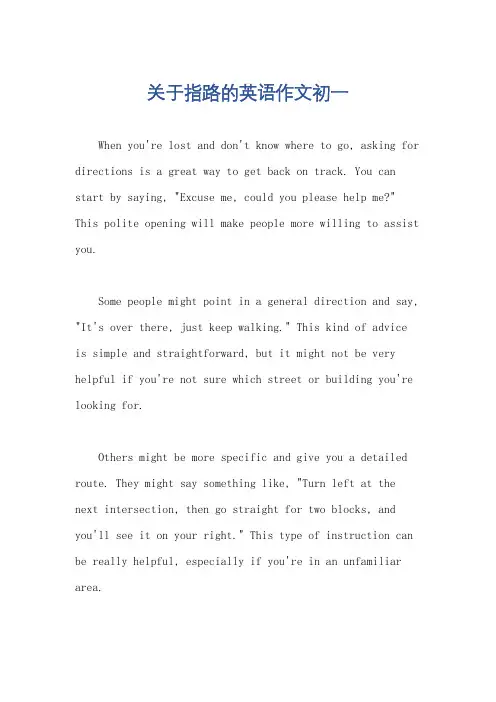
关于指路的英语作文初一When you're lost and don't know where to go, asking for directions is a great way to get back on track. You can start by saying, "Excuse me, could you please help me?" This polite opening will make people more willing to assist you.Some people might point in a general direction and say, "It's over there, just keep walking." This kind of adviceis simple and straightforward, but it might not be very helpful if you're not sure which street or building you're looking for.Others might be more specific and give you a detailed route. They might say something like, "Turn left at the next intersection, then go straight for two blocks, andyou'll see it on your right." This type of instruction can be really helpful, especially if you're in an unfamiliar area.Sometimes, people might even offer to show you the way. They might say, "Follow me, I'll take you there." This can be really nice, especially if you're feeling really lost or confused.Remember, when asking for directions, it's always good to thank the person who helps you. A simple "Thank you so much!" or "You're a lifesaver!" can make them feel appreciated and encourage others to be helpful in the future.So don't be afraid to ask for directions when you're lost. Most people are happy to help, and with a little guidance, you'll be on your way in no time!。
以指路为话题英语作文
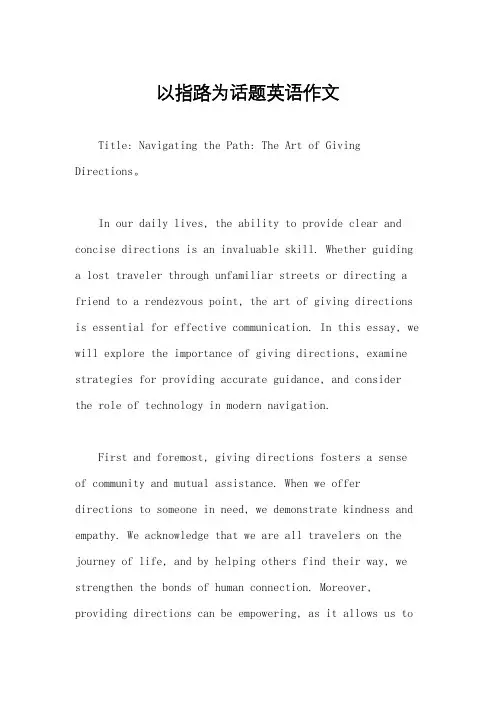
以指路为话题英语作文Title: Navigating the Path: The Art of Giving Directions。
In our daily lives, the ability to provide clear and concise directions is an invaluable skill. Whether guiding a lost traveler through unfamiliar streets or directing a friend to a rendezvous point, the art of giving directions is essential for effective communication. In this essay, we will explore the importance of giving directions, examine strategies for providing accurate guidance, and consider the role of technology in modern navigation.First and foremost, giving directions fosters a sense of community and mutual assistance. When we offerdirections to someone in need, we demonstrate kindness and empathy. We acknowledge that we are all travelers on the journey of life, and by helping others find their way, we strengthen the bonds of human connection. Moreover, providing directions can be empowering, as it allows us toshare our knowledge and expertise with others, contributing to a sense of collective well-being.Effective direction-giving relies on clarity, precision, and empathy. To ensure that our instructions are understood, we must use clear and simple language, avoiding jargon or technical terms that may confuse the listener. Additionally, we should provide context and landmarks to help orient the person receiving directions. For example, instead of saying, "Turn left at the third intersection," we could say, "Turn left at the traffic light, just after the supermarket." By incorporating visual cues and points of reference, we makeit easier for others to follow our guidance.Furthermore, empathy plays a crucial role in giving directions. We must consider the perspective of the person seeking guidance and anticipate any challenges they may encounter along the way. For instance, if someone is unfamiliar with the area, we might offer additional support by describing potential obstacles or offering alternative routes. By demonstrating empathy, we create a supportive environment where individuals feel comfortable asking forhelp and where mistakes are met with understanding rather than judgment.In recent years, technology has revolutionized the way we navigate our world. GPS devices, smartphone apps, and online mapping services have made it easier than ever tofind our way from point A to point B. While these technological advancements offer convenience and efficiency, they also raise questions about the role of humaninteraction in navigation. As we rely more on digital devices for directions, are we losing the art of giving and receiving guidance from one another?While technology certainly has its benefits, it cannot fully replace the human touch when it comes to giving directions. Unlike a GPS voice or a digital map, a human guide can offer real-time adjustments based on changing conditions or unexpected circumstances. Moreover,interacting with another person adds a personal and social dimension to the navigation process, enriching our experiences and fostering a sense of connection with our surroundings.In conclusion, the ability to give directions is a fundamental aspect of human communication. By offering clear, precise, and empathetic guidance, we not only help others find their way but also strengthen the bonds of community and compassion. While technology has its place in modern navigation, it cannot replace the human touch and the value of personal interaction. So, the next time someone asks for directions, let's embrace the opportunity to connect, guide, and navigate the path together.。
五下英语作文指路
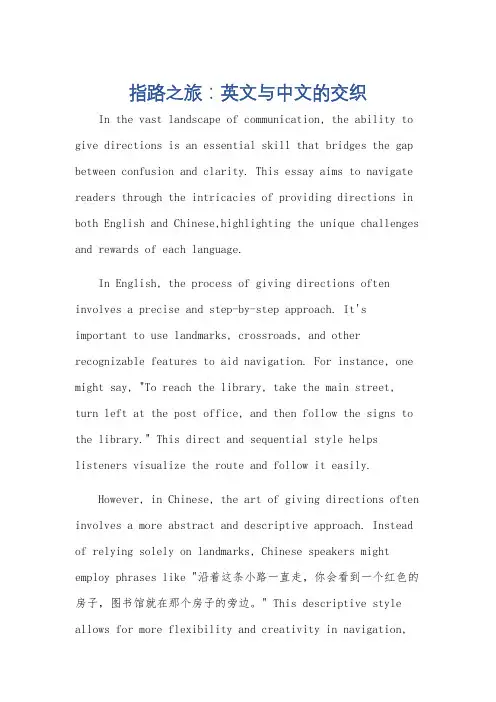
指路之旅:英文与中文的交织In the vast landscape of communication, the ability to give directions is an essential skill that bridges the gap between confusion and clarity. This essay aims to navigate readers through the intricacies of providing directions in both English and Chinese,highlighting the unique challenges and rewards of each language.In English, the process of giving directions often involves a precise and step-by-step approach. It's important to use landmarks, crossroads, and other recognizable features to aid navigation. For instance, one might say, "To reach the library, take the main street, turn left at the post office, and then follow the signs to the library." This direct and sequential style helps listeners visualize the route and follow it easily.However, in Chinese, the art of giving directions often involves a more abstract and descriptive approach. Instead of relying solely on landmarks, Chinese speakers might employ phrases like "沿着这条小路一直走,你会看到一个红色的房子,图书馆就在那个房子的旁边。
给他人指路英语作文
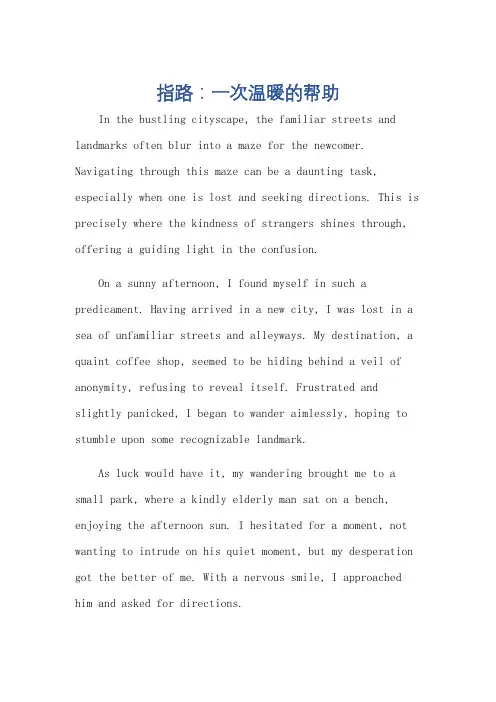
指路:一次温暖的帮助In the bustling cityscape, the familiar streets and landmarks often blur into a maze for the newcomer. Navigating through this maze can be a daunting task, especially when one is lost and seeking directions. This is precisely where the kindness of strangers shines through, offering a guiding light in the confusion.On a sunny afternoon, I found myself in such a predicament. Having arrived in a new city, I was lost in a sea of unfamiliar streets and alleyways. My destination, a quaint coffee shop, seemed to be hiding behind a veil of anonymity, refusing to reveal itself. Frustrated and slightly panicked, I began to wander aimlessly, hoping to stumble upon some recognizable landmark.As luck would have it, my wandering brought me to a small park, where a kindly elderly man sat on a bench, enjoying the afternoon sun. I hesitated for a moment, not wanting to intrude on his quiet moment, but my desperation got the better of me. With a nervous smile, I approached him and asked for directions.The man, with a warm and reassuring smile, nodded understandingly. He rose to his feet, dusting off the seat of his pants, and began to give me detailed instructions. He pointed out landmarks, described turnings, and even drew a crude map in the sand with a stick, all to ensure that I would find my way.As he spoke, his voice was filled with patience and kindness, as if he were guiding a child through a fairytale forest. His eyes sparkled with the joy of helping, and his words flowed with the ease of someone who had traveled these streets for years. I felt a sense of comfort wash over me, knowing that I was in good hands.After a few minutes, he finished his instructions and stepped back, smiling proudly at his handiwork. "You should be able to find it now," he said, his voice filled with confidence. I thanked him profusely, feeling a sense of gratitude that was difficult to express in words.As I turned to leave, he called out to me, "And remember, if you get lost again, don't hesitate to ask. People are always willing to help." His words rang in myears as I walked away, a reminder of the kindness that exists in the world.That afternoon, I not only found my way to the coffee shop but also discovered a valuable lesson in the process. The kindness of strangers, offered without expectation or reward, can be a powerful force in our lives. It can turn a frustrating situation into a pleasant experience, and it can remind us of the goodness that lies within every human heart.As I sat in the cozy coffee shop, sipping my latte and reflecting on my adventure, I realized that the true destination was not just the coffee shop but the journey itself, filled with unexpected encounters and heartwarming moments. And it was all thanks to the kindness of a stranger who, with a few simple words and a warm smile, had guided me through the maze of city streets.**指路:一次温暖的帮助**在繁华的城市风景中,对于初来乍到的人来说,熟悉的街道和地标往往会变得像迷宫一样。
英语作文关于指路
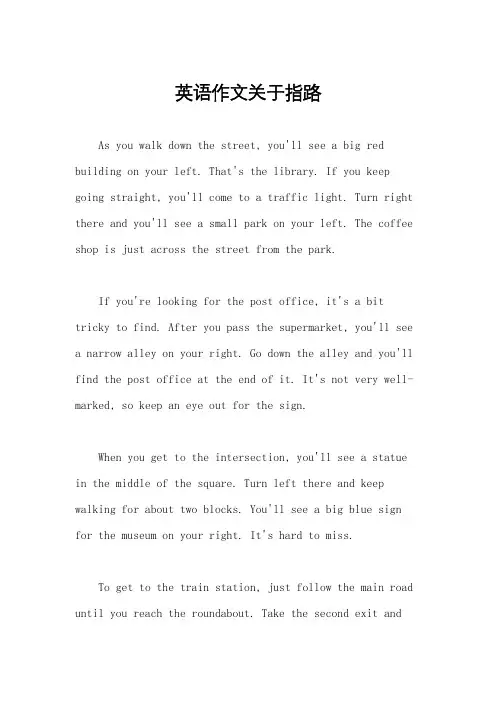
英语作文关于指路As you walk down the street, you'll see a big red building on your left. That's the library. If you keep going straight, you'll come to a traffic light. Turn right there and you'll see a small park on your left. The coffee shop is just across the street from the park.If you're looking for the post office, it's a bit tricky to find. After you pass the supermarket, you'll see a narrow alley on your right. Go down the alley and you'll find the post office at the end of it. It's not very well-marked, so keep an eye out for the sign.When you get to the intersection, you'll see a statue in the middle of the square. Turn left there and keep walking for about two blocks. You'll see a big blue sign for the museum on your right. It's hard to miss.To get to the train station, just follow the main road until you reach the roundabout. Take the second exit andyou'll see the station on your left. It's a large, modern building with glass walls.If you're trying to find the hospital, it's best to take a taxi. It's a bit out of the way and not easy to reach on foot. But if you're determined to walk, just head straight for about 20 minutes and you'll see the hospital on your right.。
指路类英语作文初三
指路类英语作文初三1. Go straight ahead for about 200 meters, then turn left at the second intersection. You will see the post office on your right.2. Keep walking until you reach the traffic lights. Cross the street and turn right. Walk past the supermarket and you will find the library on your left.3. Take the bus number 10 from the bus stop across the street. Get off at the fifth stop and you will be right in front of the park.4. Walk down the alley next to the restaurant. Keep going until you see a small bridge. Cross the bridge and turn right. The museum is just around the corner.5. Head towards the tall building with the blue roof. Turn left at the corner and walk straight until you see the school on your right.6. Follow the signs for the train station. Take the escalator down to the platform and wait for the train to arrive.7. Ask the locals for directions if you get lost. Most people are happy to help and will point you in the right direction.。
指路的英语作文4篇_0
指路的英语作文4篇各位读友大家好!你有你的木棉,我有我的文章,为了你的木棉,应读我的文章!若为比翼双飞鸟,定是人间有情人!若读此篇优秀文,必成天上比翼鸟!指路的英语作文一:指路(519字)last weekend when i was on the street a foreigner stopped me to ask directions. even though i listen to the english radio station quite often, but when the man spoke i still had trouble listening to him; he spoke so fast! i was so excited and nervous that i to k a long breath before i could answer. actually my mouth could not talk fast enough for all the words going through my head. i took my pen and a piece of paper out to draw a rough map for him. after a few short remarks of thanks and courtesies he took my map and left. everything took place within ten minutes, but i felt this short exchange was theopening of a bright new world to me.指路的英语作文二:指路(226字)libing wants to go to supermarket,but he does not know how to get there.so he asked a old man,and the old man told him to walk along the street until he see the bank and turn right to pass street 6th.he has to turn left when he see park.supermarkter is just on the right side of it.指路的英语作文三:指路(259字)dear henry,hello henry .you can take bus no.5 to the center street.and down center street has been to move forward,when to see when a big supermarket,turn right,you can enter brideg street.brideg street has been going down,my home in a small park and between the library,is a white house with gardens.lovetom指路的英语作文四:给人指路去公园(275字)the park is on the east side of the city.you can take the bus number 55 and get off at the first street.after you get off,you can walk to thebank on your right.you will see the park from there.if you ride the bike,you can go along this street for 6 blocks until you reach the first street.turn right on the street and the park will be there.各位读友大家好!你有你的木棉,我有我的文章,为了你的木棉,应读我的文章!若为比翼双飞鸟,定是人间有情人!若读此篇优秀文,必成天上比翼鸟!。
英文指路作文范文
英文指路作文范文1. Go straight ahead for about two blocks, then turn left at the second traffic light. You will see the post office on your right.2. Keep walking down this street until you reach a small park on your left. Take a right turn at the park and continue straight.3. After you pass the park, you will come across a large intersection. Cross the street and head towards the tall building on the corner.4. Once you reach the tall building, take the elevator to the fourth floor. The restaurant you're looking for is just down the hallway on your left.5. From the restaurant, go back to the main road and turn right. Walk for about five minutes until you see a bookstore on your left.6. Turn left at the bookstore and walk for another three minutes. You will find the movie theater on your right.7. To get to the train station, go back to the main road and continue walking in the same direction. Thestation will be on your left after about ten minutes.8. If you're looking for the museum, go straight ahead until you see a big statue in the middle of the square. Take a right turn and the museum will be on your left.9. To find the nearest supermarket, walk straight ahead until you reach the next intersection. Take a left turn and the supermarket will be on your right, just a few steps away.10. If you need to go to the airport, take a taxi or a bus from the city center. The airport is about 30 minutes away by car, depending on the traffic.Remember, it's always a good idea to have a map or use a navigation app on your phone to help you find your way. Good luck!。
指路的英语作文
指路的英语作文指路的英语作文(通用15篇)在我们平凡的日常里,大家都写过作文,肯定对各类作文都很熟悉吧,借助作文可以提高我们的语言组织能力。
还是对作文一筹莫展吗?以下是本店铺为大家整理的指路的英语作文,希望能够帮助到大家。
指路的英语作文 1Dear Henry,hello Henry .You can take bus No.5 to the center street.And down center street has been to move forward,when to see when a big supermarket,turn right,you can enter brideg street.Brideg street has been going down,my home in a small park and between the library,is a white house with gardens.loveTom指路的英语作文 2Last weekend when I was on the street a Foreigner stopped me to ask directions.Even Though I listen to the English radio station quite Often, but when the man spoke I still had trouble Listening to him; he spoke so fast! I was so eXcited And nervous that I to k a long breath before I could answer.Actually my mouth could not talk fast enough for all the words going through myhead.I took my pen and a piece of paper out to draw a rough map for him.After a few short remarks of thanks and courtesies he took my map and left.Everything took place within ten minutes, but I felt this short eXchange was the opening of a bright new world to me 指路的英语作文 3last weekend when i was on the street a foreigner stopped me to ask directions.even though i listen to the english radio station quite often, but when the man spoke i still had trouble listening to him; he spoke so fast! i was so ecited and nervous that i to k a long breath before i could answer.actually my mouth could not talk fast enough for all the words going through my head.i took my pen and a piece of paper out to draw a rough map for him.after a few short remarks of thanks and courtesies he took my map and left.everything took place within ten minutes,but i felt this short echange was the opening of a bright new world to me.giving directions.指路的英语作文 4you can take bus no.5 to the center street.and down center street has been to move forward,when to see when a big supermarket,turn right,you can enter brideg street.brideg street has been going down,my home in a small park and betweenthe library,is a white house with gardens.指路的英语作文 5I went to the bookstore to buy a book in this morning.When I got to a crosing,I was lost.So I went to a policeman and asked him to help,he looked the way and said to me:"You just go across from this street and turn left at the first crossing.Then you will see a big building on the right near the high school.That is it."I was very happy,because I found the store soon neXt to the high school with the polices help.指路的英语作文 6last weekend when i was on the street a foreigner stopped me to ask directions.even though i listen to the english radio station quite often, but when the man spoke i still had trouble listening to him; he spoke so fast!i was so ecited and nervous that i to k a long breath before i could answer.actually my mouth could not talk fast enough for all the words going through my head.i took my pen and a piece of paper out to draw a rough map for him.after a few short remarks of thanks and courtesies he took my map and left.everything took place within ten minutes, but i felt this short echange was the opening of a bright new world to me.指路的英语作文 7Yesterday evening , I went out for a walk with my mother .On the road , we met a foreigner .He asked me the way to the Hot Spring Hotel .I told him to walk along the road and take the third turning on the left , then he could see the hotel .He thanked me very much for my help .I was happy thatI could help him .昨天晚上,我和妈妈出去散步。
- 1、下载文档前请自行甄别文档内容的完整性,平台不提供额外的编辑、内容补充、找答案等附加服务。
- 2、"仅部分预览"的文档,不可在线预览部分如存在完整性等问题,可反馈申请退款(可完整预览的文档不适用该条件!)。
- 3、如文档侵犯您的权益,请联系客服反馈,我们会尽快为您处理(人工客服工作时间:9:00-18:30)。
指路的英语作文4篇篇一:关于用英文指路About asking the way1. 用英语问路的常用套语:Excuse me, can you tell me where the railway station is?对不起,请问火车站在哪儿? Excuse me, but can you tell me the way to the train station?劳驾,请问去火车站怎么走? Excuse me,could you tell me which is the way to the nearest hospital?请问去最近的医院怎么走?Excuse me, would you please show me the way to the post office?请告诉我去邮局怎么走好吗?Excuse me, would you mind telling me the way to the police station?对不起,请告诉我去警察局怎么走好吗?Excuse me, could you give me some directions?请你给我指指路好吗?Excuse me, can you direct me to the post office?请问到邮局怎么走?Excuse me, where‘s the men’s (ladies‘), please?请问男(女)厕所在什么地方? Excuse me, where‘s the bus station,please?请问公共汽车站在什么地方?Excuse me, how can I get to the No. 1 Middle School?请问去一中怎么走?Excuse me, could you tell me where there is a public telephone?请问哪儿有公用电话? Excuse me, is this the right way to the People‘s Park?请问去人民公园走这条路对吗? Excuse me, does this bus go to the train station?请问这公共汽车是开火车站的吗? Excuse me, I wonder if you could do me a favour. I‘m looking for the police station?对不起,不知能否帮我,我在找警察局。
Is this the only way to get there?去那儿只有这一条路吗?Which is the best way to get there?去那儿走哪条路最好呢?What street is this?这是什么街?Where does this street lead to?这条街通什么地方?2. 用英语指路的常用套语:Go down this street, and turn to the left at the first crossing. 沿着这条街走,在第一个十字路口向左拐。
Go straight on, then turn right at the second crossing. 一直走,在第二个十字路口向右拐。
Go down the road and you‘ll come to a bus stop. 沿着这条路走,你会走到一个公共汽车站。
Go straight ahead about 300 metres. 往前一直走 300米。
Go straight ahead until you come to a tall building, then turnleft. 一直往前走,一直走到一座高楼,然后向左拐。
Go this way about 5 minutes. When you come to a lane, turn right. 沿着这条路大约走5分钟。
当你走到一条小巷时,然后向右拐。
Keep going until you see a big white building on your left. 继续往前走,一直走到左边有座白色建筑。
Keep straight on for two blocks. 一直往前走,走过两条马路。
Walk until you get to the second crossing and then turn right. 一直走到第二个十字路口,然后向右拐。
Walk one block east. 朝东走过一个街区。
Take the first turning on [to] the left. 在第一个拐弯处向左拐。
Just follow this street two blocks. 沿着这条街走过两个街区就到。
Cross the street and turn left. 过了这条街,然后向左拐。
It‘s over there. 就在那边。
It‘s just around the corner. 就在拐角处。
It‘s just across the street. 就在街那边。
It‘s opposite the post office. 在邮局对面。
It‘s next to the hospital. 就在医院隔壁。
It‘s near the train station. 就在火车站附近。
It‘s on the third floor. 在三楼。
It‘s not far from here. 离这儿不远。
It‘s about 200 metres from here. 离这儿大约300米。
It‘s about five minutes’ walk. 走路五分钟就到。
It‘s about half an hour’s ride. 乘车大约半小时。
It‘s only two blocks. 只过两条马路就到。
It‘s at the end of the street. 在这条街的尽头。
Take the No 5 bus here, and get off at the next stop. 在这里乘五路车,在下一站下车。
「交际指南」1. 在向人问路之前,一般应先说句 Excuse me,这样一方面可引起对方注意,另一方面又显得比较客气。
Excuse me,译成汉语不一定总是“对不起”,此时也可译为“劳驾”,“请问”等。
若对方讲的话你没听清,你可以说 I beg your pardon?(用升调,意为:对不起,我没听清)或 Would you please say it again? I‘m afraid I didn’t quite catch you.(请再说一遍好吗?我恐怕没有完全听清)。
问完路之后,应向指路人表示感谢。
2.“向左(右)拐”英语有两种常见的说法:turn left(right)或turn to the left(right)。
表示“在左(右)边”,英语用介词on 或at 均可。
如 Turn left and walk on, and soon you‘ll see a tall building on [at] the left. (向左拐,然后继续走,不久你就会看到左边有一座高楼)。
另外,按照我国的交通规则是“行人靠右”,而在英国你会看到这样的交通标牌 Keep to the left(靠左边走)。
3. 有时人们在给对方指路后,还往往加上一些句子,以表示他的引路信息介绍完毕。
如:You can‘t miss it (你不会找不到的),You are sure to get there(你一定会到达那儿的),You can’t go wrong (你不会走错的)。
篇二:中考英语满分作文关于指路的中考英语满分作文关于指路的根据中文提示和英文提示词语,写一篇意思连贯、符合逻辑的短文。
所给英文提示词语必须都用上。
词数 60 - 70 左右。
提示词语: go out for a walk , on the road , the way to , walk along , on the left , thank for , be happy that .篇三:中考英语满分作文指路中考英语满分作文指路每年的英语中考都有写作这一考查的内容,所以同学们要重视写作的方法,消除畏惧心理,排除心理障碍。
纵观近几年中考英语写作题,题材一般是写人、写事、写物、写景、日记、书信、通知、便条等文体。
一般来说,不同的写作题材,它的人物,时间,写作的重点也是不尽相同的。
下面简单介绍一下中考英语写作六个要素:审题清,要点明,列提纲,全文顺,无病句,打草稿。
审题要清看到考题后,先不要急于动笔,要仔细看清题目要求的内容。
在自己的头脑中构思出一个框架或画面,确定短文的中心思想,不要匆匆下笔,看懂题意,根据提供的资料和信息来审题。
审题要审格式、体裁、人物关系、故事情节、主体时态、活动时间、地点等。
要点明确要点是给分的一个重要因素。
为了防止写作过程中遗漏要点,同学们要充分发挥自己的观察力,把情景中给出的各个要点逐一罗列出。
列出提纲为写作做好准备。
根据文章要点短文的中心思想将主要句型、关键词语记下,形成提纲。
写顺全文写短文时要做到五个方面:1.避免使用汉语式英语,尽量使用自己熟悉的句型。
2.多用简单句型,记事、写人一般都不需要复杂的句型。
可适当多使用陈述句、一般疑问句、祈使句和感叹句。
不用或少用非谓语或独立主格结构等较复杂的句型。
3.注意语法、句法知识的灵活运用。
语态、时态要准确无误;主谓语要一致,主语的人称和数要和谓语一致;注意冠词用法,例如:It takes Tomhalf an hour to go to school by bus.中的an不能写成a;注意拼写,例如:fourteen,forty,ninth等不要写成forteen,fourty,nineth 等;注意标点符号和大小写。
4.描写人物时,要生动具体,可以选择使用下列词汇,例如:外形:tall,short,fat,thin,strong,weak,pretty等;颜色:red,yel -low,blue,white,green,brown,black等;心情:glad,happy,sad,excited,anxious,interest-ed等;情感:love,like,hate,feel,laugh,cry,smile,shout等。
5.上下文要连贯。
同学们应把写好的句子,根据故事情节,事情发生的先后次序(时间或空间),使用一些表示并列、递进等过渡词进行加工整理,使文章连贯、自然、流畅。
